新编简明英语语言学Chapter9Languageandculture
- 格式:docx
- 大小:31.66 KB
- 文档页数:7
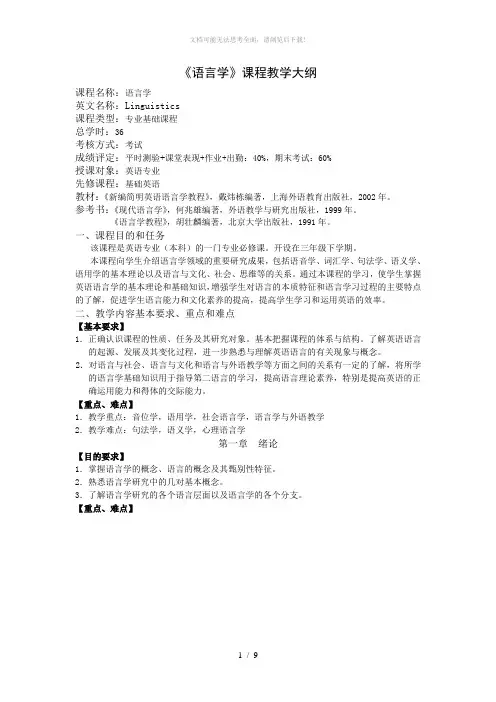
《语言学》课程教学大纲课程名称:语言学英文名称:Linguistics课程类型:专业基础课程总学时:36考核方式:考试成绩评定:平时测验+课堂表现+作业+出勤:40%,期末考试:60%授课对象:英语专业先修课程:基础英语教材:《新编简明英语语言学教程》,戴炜栋编著,上海外语教育出版社,2002年。
参考书:《现代语言学》,何兆雄编著,外语教学与研究出版社,1999年。
《语言学教程》,胡壮麟编著,北京大学出版社,1991年。
一、课程目的和任务该课程是英语专业(本科)的一门专业必修课。
开设在三年级下学期。
本课程向学生介绍语言学领域的重要研究成果,包括语音学、词汇学、句法学、语义学、语用学的基本理论以及语言与文化、社会、思维等的关系。
通过本课程的学习,使学生掌握英语语言学的基本理论和基础知识,增强学生对语言的本质特征和语言学习过程的主要特点的了解,促进学生语言能力和文化素养的提高,提高学生学习和运用英语的效率。
二、教学内容基本要求、重点和难点【基本要求】1.正确认识课程的性质、任务及其研究对象。
基本把握课程的体系与结构。
了解英语语言的起源、发展及其变化过程,进一步熟悉与理解英语语言的有关现象与概念。
2.对语言与社会、语言与文化和语言与外语教学等方面之间的关系有一定的了解,将所学的语言学基础知识用于指导第二语言的学习,提高语言理论素养,特别是提高英语的正确运用能力和得体的交际能力。
【重点、难点】1.教学重点:音位学,语用学,社会语言学,语言学与外语教学2.教学难点:句法学,语义学,心理语言学第一章绪论【目的要求】1.掌握语言学的概念、语言的概念及其甄别性特征。
2.熟悉语言学研究中的几对基本概念。
3.了解语言学研究的各个语言层面以及语言学的各个分支。
【重点、难点】1.教学重点:语言学的概念、语言的概念及其甄别性特征。
2.教学难点:语言学研究中的几对基本概念。
【教学方法与教学手段】讲授式、讨论式【教学时数】2学时【思考与练习】1﹒How do you interpret the definition of linguistics: Linguistics is the scientific study of language?2﹒What are the major branches of linguistics? What does each of them study?3﹒What characteristics of language should be included in a good , comprehensive definition of language?4﹒What are the main features of human language that have been specified by C. Hockett to show that it is essentially different from animal communication system?第二章音系学【目的要求】1.通过语音学部分的学习,了解各种发音器官及其作用,英语的元音和辅音的发音方式和特点,分清宽式标音法和窄式标音法的区别。
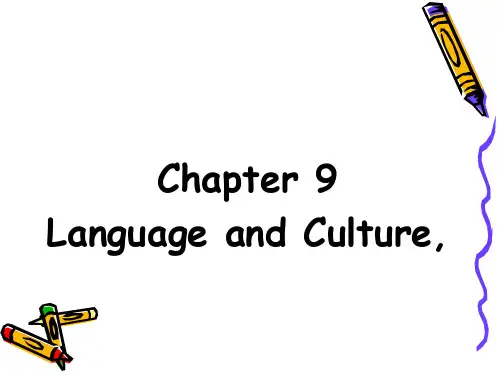
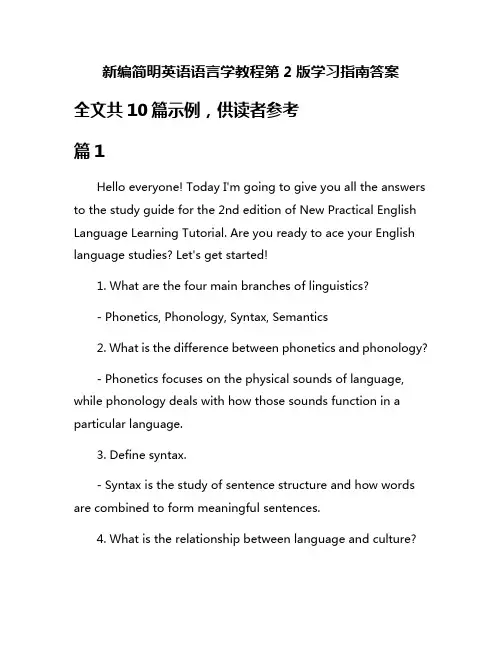
新编简明英语语言学教程第2版学习指南答案全文共10篇示例,供读者参考篇1Hello everyone! Today I'm going to give you all the answers to the study guide for the 2nd edition of New Practical English Language Learning Tutorial. Are you ready to ace your English language studies? Let's get started!1. What are the four main branches of linguistics?- Phonetics, Phonology, Syntax, Semantics2. What is the difference between phonetics and phonology?- Phonetics focuses on the physical sounds of language, while phonology deals with how those sounds function in a particular language.3. Define syntax.- Syntax is the study of sentence structure and how words are combined to form meaningful sentences.4. What is the relationship between language and culture?- Language and culture are closely intertwined, as language reflects the beliefs, values, and norms of a particular culture.5. What is the purpose of semantics?- Semantics is the study of meaning in language, including how words and sentences convey different shades of meaning.6. Explain the difference between a morpheme and a phoneme.- A morpheme is the smallest unit of meaning in language, while a phoneme is the smallest unit of sound.7. What is the International Phonetic Alphabet (IPA) used for?- The IPA is a standardized system for representing the sounds of language, making it easier to study and compare different languages.8. Describe the difference between a declarative and an interrogative sentence.- A declarative sentence makes a statement, while an interrogative sentence asks a question.9. What is pragmatics?- Pragmatics is the study of how language is used in context, including how speakers convey meaning through tone, gesture, and social cues.10. Give an example of a language register.- Formal register: "I am delighted to make your acquaintance."- Informal register: "Nice to meet you!"That's it for the study guide answers! I hope this helps you all with your English language studies. Good luck, and keep practicing!篇2Hi, everyone! Are you ready to learn about the New Concise English Linguistics Study Guide 2nd Edition? Let's dive right in!First of all, this book is super cool because it teaches you all about the English language and how it works. You'll learn about things like grammar, phonetics, and syntax – all those fancy words that linguists use to talk about language.One of the best parts of this book is the exercises and activities. They help you practice what you've learned and make sure you really understand it. Plus, there are lots of fun gamesand puzzles to help you remember all those tricky linguistic terms.Another awesome thing about this book is that it's really clear and easy to understand. The authors explain everything in a way that's simple and straightforward, so you won't get confused. And if you do have questions, there's a handy glossary at the back of the book to help you out.But wait, there's more! The Study Guide also includes tips and tricks for improving your English skills, like how to study effectively and how to write better essays. So not only will you learn about linguistics, but you'll also become a better English speaker and writer.So, if you want to become a language expert and impress your friends with your linguistic knowledge, make sure to grab a copy of the New Concise English Linguistics Study Guide 2nd Edition. Happy learning!篇3Hi guys, today I’m going to share with you some answers to the study guide for the New Edition of the Concise English Language Studies. This book can be a bit tricky, but don’t worry, I’ve got your back! Let’s get started:1. What is the definition of linguistics?Linguistics is the scientific study of language and its structure, including the study of grammar, syntax, phonetics, and semantics.2. How many main branches make up the field of linguistics?There are six main branches of linguistics: phonetics, phonology, morphology, syntax, semantics, and pragmatics.3. What is the difference between descriptive and prescriptive grammar?Descriptive grammar describes how language is actually used by speakers, while prescriptive grammar dictates how language should be used according to traditional rules.4. What is the International Phonetic Alphabet (IPA) used for?The International Phonetic Alphabet is used to represent sounds of spoken languages in a standardized way, making it easier to transcribe and study different languages.5. Explain the difference between a morpheme and a phoneme.A morpheme is the smallest unit of meaning in a language, while a phoneme is the smallest unit of sound that can distinguish meaning between words.I hope these answers help you with your studies. Remember, learning English can be challenging, but with practice and determination, you’ll get the hang of it! Good luck, everyone!篇4Hello everyone, I'm so excited to share with you the study guide for "A New Introduction to English Language Teaching2nd Edition". This book may seem a bit tough at first, but don't worry, I'll break it down for you in a fun and easy way!Chapter 1: What is Language?In this chapter, we learn that language is a way for us to communicate with each other. It can be spoken, written, or signed. We also learn about the different parts of speech, like nouns, verbs, adjectives, and adverbs. Remember, practice makes perfect, so try to use different words in your sentences!Chapter 2: The Sounds of LanguageThis chapter talks about phonetics and phonology, which are fancy words for the sounds we make when we talk. Rememberwhen your teacher taught you how to pronounce words like "cat" and "dog"? That's phonetics! Make sure to practice saying words out loud to improve your pronunciation.Chapter 3: The Structure of WordsWords are like building blocks that make up sentences. In this chapter, we learn about morphology, which is the study of how words are formed. Break down words into prefixes, suffixes, and roots to understand their meanings better.Chapter 4: Sentences and MeaningSentences are like puzzles that convey meaning. In this chapter, we learn about syntax, which is how words are put together to form sentences. Pay attention to the order of words in a sentence to understand the intended meaning.Chapter 5: Language VariationLanguages can vary based on where you are or who you're talking to. In this chapter, we learn about dialects, accents, and regional variations. Embrace the diversity of language and learn from different people's ways of speaking.Chapter 6: Language ChangeLanguages evolve over time, just like how your favorite video game updates with new features. In this chapter, we learn about language history and how words change meaning over time. Keep up with the latest slang and trends to stay current!So there you have it, a simplified guide to "A New Introduction to English Language Teaching 2nd Edition". Remember to have fun while studying and don't be afraid to ask questions. Happy learning, everyone!篇5Hey guys! Today I'm going to give you all the answers to the Study Guide of "New Concise English Language Learning Tutorial 2nd Edition". Are you ready? Let's get started!Chapter 1: Introduction to English Language Learning1. Describe the importance of learning English as a global language.- Learning English is important because it is spoken by millions of people all around the world. It can help you communicate with people from different countries and cultures.2. List the four main skills in language learning.- The four main skills in language learning are listening, speaking, reading, and writing.Chapter 2: Phonetics and Phonology1. What is the difference between phonetics and phonology?- Phonetics is the study of the sounds of human speech, while phonology is the study of how sounds are organized and used in language.2. Give an example of a minimal pair.- An example of a minimal pair is the words "pat" and "bat". The only difference between these two words is the initial sound (/p/ in "pat" and /b/ in "bat").Chapter 3: Morphology and Syntax1. Define morphology and syntax.- Morphology is the study of the structure and formation of words, while syntax is the study of how words are combined to form sentences.2. What is the difference between inflection and derivation?- Inflection is the modification of a word to indicate grammatical information like tense, number, and gender, whilederivation is the formation of new words by adding prefixes or suffixes.Chapter 4: Semantics and Pragmatics1. Explain the difference between semantics and pragmatics.- Semantics is the study of the meaning of words and sentences, while pragmatics is the study of how language is used in context to achieve certain goals.2. Give an example of a semantic field.- An example of a semantic field is the words related to animals, such as cat, dog, and bird.I hope these answers help you with your studies! Keep practicing and don't forget to have fun learning English! Good luck!篇6Hello everyone! Today I'm going to share with you the study guide for the New Edition of Brief English Linguistics Tutorial 2.First of all, make sure to read the textbook carefully and understand the key concepts. It's important to pay attention tothe examples and explanations given in the book to help you grasp the information better.Secondly, practice is key to mastering any language skill. Try to do the exercises at the end of each chapter and review the grammar and vocabulary regularly. You can also find additional exercises online or make flashcards to help you memorize the new words.Don't forget to listen to English audio materials such as podcasts, songs, or news broadcasts. This will help you improve your listening skills and get used to the natural rhythm and pronunciation of English.When it comes to speaking, try to practice speaking English with your friends, family, or classmates. You can also join a language exchange group or find a language partner to practice speaking with.Lastly, have fun while learning English! Watch English movies, read English books or comics, and explore different aspects of English language and culture. Remember, practice makes perfect, so keep practicing and don't give up!I hope these tips will help you improve your English language skills and have fun learning along the way. Good luck and happy studying!篇7Hey guys, have you started studying the New Edition of A Concise English Language Course Book 2? It might feel a bit tricky at first, but don't worry, I'm here to help you out with a study guide that will make things much easier for you!First off, make sure you understand the key concepts in each chapter before moving on to the exercises. Pay attention to the explanations and examples given in the book, as they will help you grasp the material better.When it comes to doing the exercises, don't rush through them. Take your time to read the instructions carefully and think about your answers before writing them down. If you're unsure about something, don't hesitate to ask your teacher or a classmate for help.Make good use of the practice tests and drills provided in the book. They will help you reinforce what you've learned and identify any areas where you might need to improve.Remember to review your notes regularly and test yourself on the vocabulary and grammar rules you've learned. This will help you retain the information better and be better prepared for exams.Lastly, don't forget to have fun while studying! Learning a new language can be challenging, but it can also be a lot of fun. So keep a positive attitude and stay motivated.Good luck with your studies, and I'm sure you'll do great in your English language course! Keep up the good work!篇8Hey guys! Today I'm going to give you all the answers to the "New Edition Concise English Linguistics Course 2" study guide. Get ready to ace your test with these answers!1. What is the definition of linguistics?Linguistics is the scientific study of language and its structure, including grammar, syntax, semantics, and phonetics.2. What are the different branches of linguistics?There are several branches of linguistics, including phonetics, phonology, morphology, syntax, semantics, and pragmatics.3. What is the difference between phonetics and phonology?Phonetics is the study of the physical sounds of speech, while phonology is the study of how those sounds are used in a particular language to create meaning.4. What is morphology?Morphology is the study of the structure of words and how they are formed, including prefixes, suffixes, and roots.5. What is syntax?Syntax is the study of sentence structure and how words are arranged to create meaning in a sentence.6. What is semantics?Semantics is the study of meaning in language, including how words and sentences convey information and how meaning can change in different contexts.7. What is pragmatics?Pragmatics is the study of how language is used in real-life situations, including the social and cultural factors that influence communication.8. How can linguistics help us understand language better?Studying linguistics can help us understand how language works, why languages are structured the way they are, and how language shapes our thoughts and behaviors.So there you have it, all the answers to the "New Edition Concise English Linguistics Course 2" study guide. Good luck on your test, and keep on learning about language!篇9Hello everyone! Today I'm gonna share with you the answers to the study guide of "A New Introduction to English Language Study, 2nd edition". So let's dive in and check out the answers together!Chapter 1: Introduction to English Language Study1. What is linguistics?Answer: Linguistics is the scientific study of language and its structure.2. What are the four main branches of linguistics?Answer: The four main branches of linguistics are phonetics, phonology, morphology, and syntax.3. What is the difference between descriptive and prescriptive grammar?Answer: Descriptive grammar describes how people actually use language, while prescriptive grammar dictates how people should use language according to established rules.Chapter 2: Phonetics and Phonology1. What is the difference between phonetics and phonology?Answer: Phonetics focuses on the physical sounds of speech, while phonology studies the patterns of sounds in language.2. What is a phoneme?Answer: A phoneme is the smallest unit of sound that can distinguish meaning in a language.3. Give an example of a minimal pair.Answer: Ship and sip are an example of a minimal pair, as changing the initial sound changes the meaning of the word.Chapter 3: Morphology and Syntax1. What is morphology?Answer: Morphology is the study of the structure of words and how they are formed.2. What is a morpheme?Answer: A morpheme is the smallest unit of meaning in language.3. What is syntax?Answer: Syntax is the study of how words are combined to form sentences.I hope these answers help you with your studies! Keep up the good work and have fun learning about the English language!篇10Title: A Fun Guide to Learning English from New Edition of Concise English Language Learning GuideHey guys! Are you ready to dive into the exciting world of learning English with the new edition of the Concise English Language Learning Guide? In this guide, we will explore the basics of English language study and provide you with some awesome tips and tricks to help you improve your English skills.First and foremost, it's important to understand that learning English is all about practice and consistency. Make sure to set aside some time each day to study and review the material in theguide. Whether it's reading, writing, speaking, or listening, make sure to practice all four language skills to become awell-rounded English speaker.One helpful tip is to keep a vocabulary notebook to write down new words you learn. You can also use flashcards to help you memorize and review vocabulary regularly. Remember, repetition is key when it comes to learning new words and phrases!Another great way to improve your English skills is to watch English movies or TV shows, and listen to English songs. This will help you get used to the sounds and rhythms of the English language. You can also try practicing speaking with a friend or classmate to improve your pronunciation and fluency.In addition, don't be afraid to make mistakes! Learning a new language is a journey, and it's completely normal to make errors along the way. Take risks, practice, and don't be afraid to speak up and use your English skills in real-life situations.Overall, the key to success in learning English is to stay motivated, practice regularly, and have fun with it! With the help of the new edition of the Concise English Language Learning Guide, you'll be on your way to mastering English in no time. Good luck, and happy learning!。

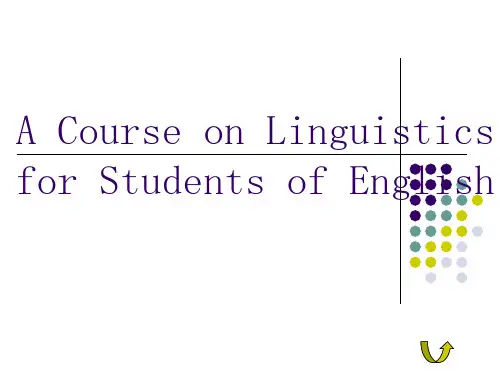
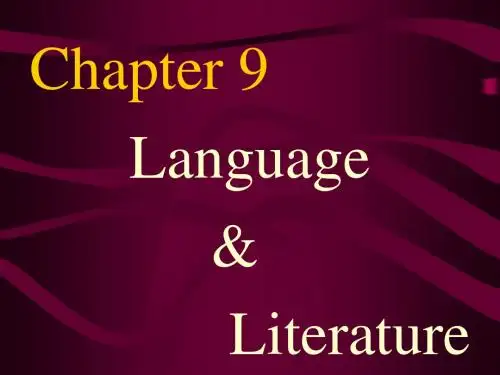
![[整理]新编简明英语语言学教程笔记](https://uimg.taocdn.com/2e7dfbc2a48da0116c175f0e7cd184254b351b3b.webp)
新编简明英语语言学教程笔记Chapter one Introduction一、定义1.语言学LinguisticsLinguistics is generally defined as the scientific study of language.2.普通语言学General LinguisticsThe study of language as a whole is often called General linguistics.3.语言languageLanguage is a system of arbitrary vocal symbols used for human communication.语言是人类用来交际的任意性的有声符号体系。
4.识别特征Design FeaturesIt refers to the defining poperties of human language that distinguish it from any animal system of communication.Arbitrariness任意性Productivity多产性Duality双重性Displacement移位性Cultural transmission文化传递⑴arbitrarinessThere is no logical connection between meanings and sounds.P.S the arbitrary nature of language is a sign of sophistication and it makes it possible for language to have an unlimited source of expressions⑵ProductivityAnimals are quite limited in the messages they are able to send.⑶DualityLanguage is a system, which consists of two sets of structures ,or two levels.⑷DisplacementLanguage can be used to refer to contexts removed from the immediate situations of the speaker.⑸Cultural transmissionHuman capacity for language has a genetic basis, but we have to be taught and learned the details of any language system. this showed that language is culturally transmitted. not by instinct. animals are born with the capacity to produce the set of calls peculiar to their species.二、知识点nguage is not an isolated phenomenon, it‘s a social activity carried out in a certain social environment by human beings.语言不是一种孤立的现象,而是人类在一定的社会环境下进行的一种社会活动。
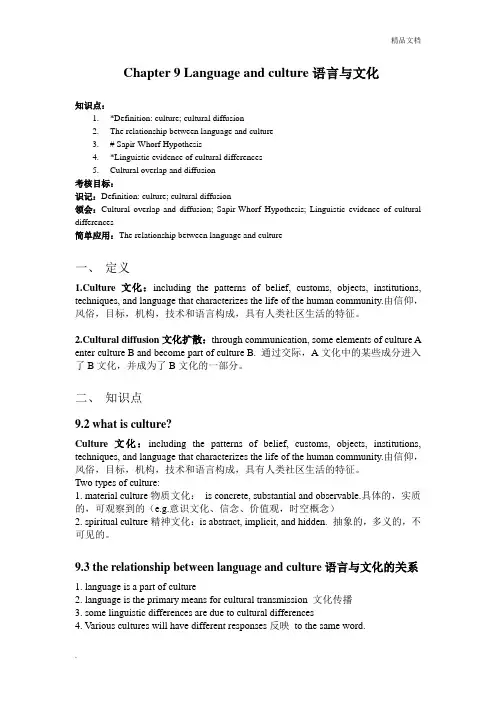
Chapter 9 Language and culture语言与文化知识点:1.*Definition: culture; cultural diffusion2.The relationship between language and culture3.# Sapir-Whorf Hypothesis4.*Linguistic evidence of cultural differences5.Cultural overlap and diffusion考核目标:识记:Definition: culture; cultural diffusion领会:Cultural overlap and diffusion; Sapir-Whorf Hypothesis; Linguistic evidence of cultural differences简单应用:The relationship between language and culture一、定义1.Culture文化:including the patterns of belief, customs, objects, institutions, techniques, and language that characterizes the life of the human community.由信仰,风俗,目标,机构,技术和语言构成,具有人类社区生活的特征。
2.Cultural diffusion文化扩散:through communication, some elements of culture A enter culture B and become part of culture B. 通过交际,A文化中的某些成分进入了B文化,并成为了B文化的一部分。
二、知识点9.2 what is culture?Culture文化:including the patterns of belief, customs, objects, institutions, techniques, and language that characterizes the life of the human community.由信仰,风俗,目标,机构,技术和语言构成,具有人类社区生活的特征。
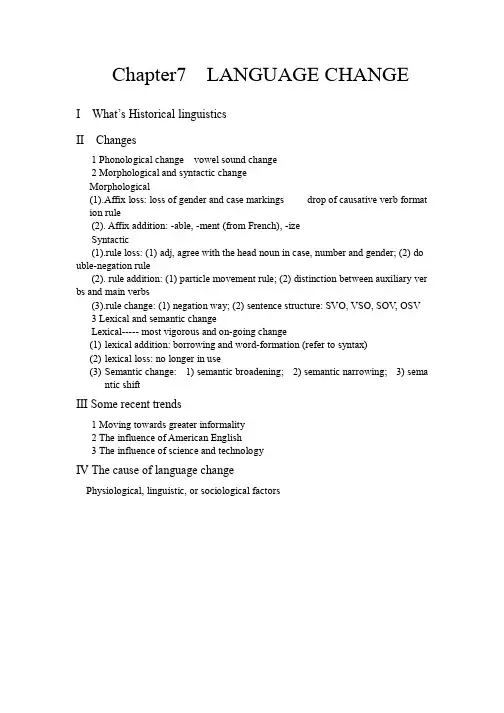
Chapter7 LANGUAGE CHANGE I What’s Historical linguisticsII Changes1 Phonological change vowel sound change2 Morphological and syntactic changeMorphological(1).Affix loss: loss of gender and case markings drop of causative verb formation rule(2). Affix addition: -able, -ment (from French), -izeSyntactic(1).rule loss: (1) adj, agree with the head noun in case, number and gender; (2) do uble-negation rule(2). rule addition: (1) particle movement rule; (2) distinction between auxiliary ver bs and main verbs(3).rule change: (1) negation way; (2) sentence structure: SVO, VSO, SOV, OSV3 Lexical and semantic changeLexical----- most vigorous and on-going change(1)lexical addition: borrowing and word-formation (refer to syntax)(2)lexical loss: no longer in use(3)Semantic change: 1) semantic broadening; 2) semantic narrowing; 3) semantic shiftIII Some recent trends1 Moving towards greater informality2 The influence of American English3 The influence of science and technologyIV The cause of language changePhysiological, linguistic, or sociological factorsChapter8 LANGUAGE AND SOCIETYI.The scope of sociolinguistics1.The relatedness between language and society2. Speech community and speech varietySC: speech community is a social group singled out for any special studySV:language variety refers to any distinguishable form of speech used by a speaker or group of speakers.II Variety of language1 Dialectal varieties(1)Regional dialects is a speech variation according to the particular area wherea speaker comes from, which is the most discernible and definabledialects)(2)Sociolect linguistic differences associated with respective definable socialgroups even within the same geographical location(3)Language and gender(4)Language and age(5)Idiolect is a personal dialect of an individual speaker that combines aspects ofall the elements regarding regional, social, and stylistic variation, in one way or another(6)Ethnic dialect2 RegistersField of discourseTenor of discourse’Mode of discourseIII Standard dialectThe standard language is a superposed, socially prestigious dialect of language IV Pidgin and CreolePidgin: is a variety of language that is generally used by native of speakers of other languages as a medium of communication. Itmay contain significant grammatical features of two or more languages, but rule-governed.Creole: is originally a pidgin that has become established as a native language in som e speech community. A pidgin becomes a Creole when it is adopted by a population as its primary language, and children learn it as their first languageV.Bilingualism and diglossiaBilingualism: refers to a linguistic situation in which two standard languages are used either by an individual or by a group of speakers, such as the inhabitants of a particul ar regions or a nation.Diglossia: is a situation in which two very different varieties of language co-exist in a speech community, each with a distinct range of purely social functions and appropria te for certain situations. One is a more standard variety called the high variety (H-vari ety), the other is a non-prestige variety called the low variety (L-variety) Chapter9 LANGUAGE AND CULTUREI What is cultureBroadly speaking, it means the total way of life of a people, including the patterns of belief, customs, objects, institutions, techniques, and language.In a narrow sense, it refers to local or specific practice, beliefs or customs.II The relationship between language and cultureThe relation of L to C is that of part to whole, for L is part of C.The knowledge and beliefs that constitute a people’s culture are habitually encoded and transmitted in LIII Sapir-Whorf Hypothesis1 Linguistic determinism -- refers to the notion that a language determines certain nonlinguistic cognitive processes. Different languages offer people different ways of expressing around, they think and speak differently.2 Linguistic relativity-- refers to the claim that the cognitive processes that are determined are different for different languages. Thus, speakers of different languages are said to think in different ways.IV Linguistic evidence of cultural differences1 Greetings and terms of address2 Gratitude and compliments3 Color words4 Privacy and taboos5 Rounding off numbers6 Words and culture-specific connotations7 Culture-related idioms,proverbs and metaphorsV The significance of cultural teaching and learing1 To get the students familiar with cultural differences;2 To help the students transcend their own culture and see things as the members of the target culture will;3 To emphasize the inseparability of understanding language and understanding culture through various classroom practicesChapter10 LANGUAGE ACQUISITION Language acquisition refers to children’s development of their first language, that is, t he native language of the community in which a child has been brought up (naturally and successfully).I Theories of child language acquisition—three different theories concerning how language is learned1 The behaviorist Imitation—Practice2 The innatist LAD3 The interactionistII Cognitive development in child language development1 Language development is dependent on both the concepts children form about the w orld and what they feel stimulated to communicate at the early and later stages of their language development2 The cognitive factors determine how the child makes sense of the linguistic system himself instead of what meanings the child perceives and expresses.III Language environment and the Critical Period HypothesisIV Stage in child language developmentPhonological developmentV ocabulary development1) Under-extension2) Over-extension3) Prototype theoryGrammatical development1) Telegraphic speech2) Sentences of three main elements Pragmatic developmentV Atypical developmentAtypical or abnormal language development occurs due to trauma or injury. Atypical language development includes:Hearing impairmentMental retardationautismstutteringAphasiaDyslexia and dysgraphiaChapter11 SECOND LANGUAGEACQUISITIONSecond Language Acquisition ---- formally established itself as a discipline around the 1970s, refers to the systematic study of how one person acquires a second language subsequent to his native language.I Connections between first language acquisition and second language acquisitionThe first language study has influenced enormously those on the second language acquisition at both theoretical and practical levels.SLA is different from first language acquisition.II Contrastive analysisIII Error analysisTwo main sorts of errors: Interlingual errors intralingual errorsOvergeneralizationIV The role of native language in second language learning1 Language transfer: positive and negative2 Three interacting factors in determining language transfer:1)A learner’s psychology2)Perception of native-target language distance3)Actual knowledge of the target languageV Second language learning models and input hypothesis1 Behaviorism model emphasizes the role of imitation and positive reinforcement, a “nurture” position;2 The mentalists or the innativists shift to a “nature” position by stressing that human beings equipped innately with language acquisition device, are capable of language learning provided with adequate language input.3 The social interactionists argue that language and social interaction cannot be separated.VI Individual differences1 Language aptitude2 Motivation3 Learning strategies4 Age of acquisition5 PersonalityChapter12 LANGUAGE AND THEBRAINLanguage is a mirror of the mind in a deep and significant sense. It is a product of human intelligence, created anew in each individual by operations that lie far beyond the reach of will or consciousnessI Neurolinguistics1 What is neurolinguistics?2 The structure and function of the human brain3Methods in the study of the brain and evidencefor lateralizationAutopsy studies;–Methods to study the brain&–Methods to study the behavior associated with thebrain4 Aphasia;–Broaca’s aphasia–Wernicke’s aphasia–Acquired dyslexiaII Psycholinguistics1 What is psycholinguistics?2 Psycholinguistic research method–Field work–Experimental methodsLexical Decision;The priming experimentTimed-reading experimentsEye-movement experimentsEvent-related potential experiment3 Linguistics and language processing–Bottom-up vs. top-down processing–Phonetics and phonology;–Morphological processing–Syntax: garden path sentence4 Psycholinguistic modelling;–Levelt’s model of speech production ;新编简明英语语言学教程7-12章总结班级:英语1001姓名:王晶学号:1005100105。
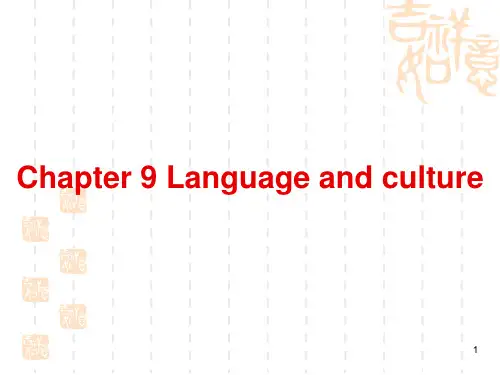
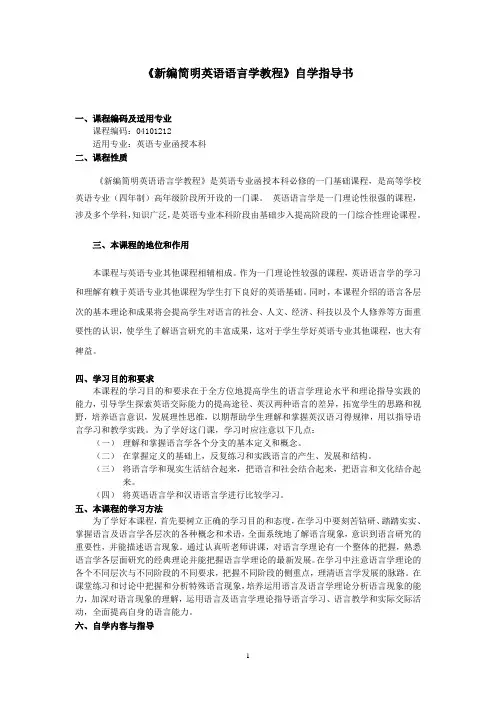
《新编简明英语语言学教程》自学指导书一、课程编码及适用专业课程编码:04101212适用专业:英语专业函授本科二、课程性质《新编简明英语语言学教程》是英语专业函授本科必修的一门基础课程,是高等学校英语专业(四年制)高年级阶段所开设的一门课。
英语语言学是一门理论性很强的课程,涉及多个学科,知识广泛,是英语专业本科阶段由基础步入提高阶段的一门综合性理论课程。
三、本课程的地位和作用本课程与英语专业其他课程相辅相成。
作为一门理论性较强的课程,英语语言学的学习和理解有赖于英语专业其他课程为学生打下良好的英语基础。
同时,本课程介绍的语言各层次的基本理论和成果将会提高学生对语言的社会、人文、经济、科技以及个人修养等方面重要性的认识,使学生了解语言研究的丰富成果,这对于学生学好英语专业其他课程,也大有裨益。
四、学习目的和要求本课程的学习目的和要求在于全方位地提高学生的语言学理论水平和理论指导实践的能力,引导学生探索英语交际能力的提高途径、英汉两种语言的差异,拓宽学生的思路和视野,培养语言意识,发展理性思维,以期帮助学生理解和掌握英汉语习得规律,用以指导语言学习和教学实践。
为了学好这门课,学习时应注意以下几点:(一)理解和掌握语言学各个分支的基本定义和概念。
(二)在掌握定义的基础上,反复练习和实践语言的产生、发展和结构。
(三)将语言学和现实生活结合起来,把语言和社会结合起来,把语言和文化结合起来。
(四)将英语语言学和汉语语言学进行比较学习。
五、本课程的学习方法为了学好本课程,首先要树立正确的学习目的和态度,在学习中要刻苦钻研、踏踏实实、掌握语言及语言学各层次的各种概念和术语,全面系统地了解语言现象,意识到语言研究的重要性,并能描述语言现象。
通过认真听老师讲课,对语言学理论有一个整体的把握,熟悉语言学各层面研究的经典理论并能把握语言学理论的最新发展。
在学习中注意语言学理论的各个不同层次与不同阶段的不同要求,把握不同阶段的侧重点,理清语言学发展的脉路。
第一章:绪论1.什么是语言学?1.1定义语言学常被定义为是对语言进行系统科学研究的学科。
语言学研究的不是某一种特定的语言,而是人类所有的语言。
为了揭示语言的本质,语言学家首先要对语言实际使用进行观察,并在此基础上形成有关语言使用的概括性假设,这些初步形成的假设要在语言使用中进行进一步的检验,最终形成一条语言理论。
1.2语言学的研究范畴:语言学研究有不同的侧重。
对语言体系作全面研究的语言学研究称为普通语言学。
语音学主要是对语言声音媒介的研究,它不只是研究某一特定的语言的声音媒介,而是所有语言的声音媒介。
音系学与语音学不同,它主要研究特定语言的语音体系,即音是如何结合在一起产生有意义的单位。
形态学主要研究单词的内部语义结构,及这些叫做词素的语义最小单位是如何结合构成单词。
句法学主要研究构成潜在句子的句法规则。
语义学以研究语义为目的,传统语义学主要研究抽象的意义,独立于语境之外的意义,语用学也是研究语义,但是它把语义研究置于语言使用语境中加以研究。
语言不是一个孤立的现象,而是一种社会现象,各种社会因素都会对语言的使用产生影响。
从社会的角度来研究语言的科学被称之为社会语言学。
语言和社会之间的关系是社会语言学研究的主要内容。
心理语言学主要从心理学的角度来研究语言。
它要研究人们在使用语言时大脑的工作机理,如人是如何习得母语的,人的大脑是如何加工和记忆语言信息等问题。
把语言学的研究成果应用到实践中的科学形成了应用语言学。
狭义上,应用语言学指把语言理论和原则运用于语言教学的科学,在广义上,它指把语言理论与原则应用于解决实际问题的科学。
除此之外还有人类语言学、神经语言学、数学语言学、计算语言学等。
1.3语言学研究中的几对基本概念1.3.1规定性和描述性语言学研究是描述性的,不是规定性的。
这是语言学和传统语法的一个重要区别。
语言学研究的目的是对人们使用的语言进行客观描述与分析,而不是对语言的使用作出规定。
传统语法是规定性的,它主要建立在笔头语言基础之上,旨在规定一系列的语法规则,并且把这些语法规则强加给语言使用者。
新编简明英语语言学教程(重点笔记-赶考秘籍)新编简明英语语言学教程(重点笔记-赶考秘籍)1.1 Linguistics is generally defined as the scientific study of language.It is a scientific study because it (a) is based on the systematic investigation of linguistic data. It (b) discovers the nature and rules of the underlying language system. It (c) collects language facts that display some similarities, and generalizations are made about them.The study of language as a whole if often called general linguistics.phonetics(语音学): the study of soundsphonology(音位学): how sounds are put together and used to convey meaningmorphology(形态学): how morphemes(词素) are arranged and combined to form wordssyntax(句法学): the study of rules that govern the combination of words to form grammatically permissible sentencessemantics(语义学): the study of meaningpragmatics(语用学): the study of meaning in the context of language useinterdisciplinary branches: sociolinguistics(社会语言学), psycholinguistics(心理语言学), applied linguistics(应用语言学) Important distinctions in linguisticsprescriptive(规定性old linguistics) vs. descriptive(描述性modern linguistics)synchronic(共时性) vs. diachronic(历时性): most linguistic studies are of synchronic descriptions, which is prior in modernlinguisticsspeech and writing: speech is prior to writing in modern linguisticslangue(语言系统abstract linguistic system) and parole(话语/言语realization of langue in actual use): Swiss linguist F. de Saussure----forefather of modernlinguisticscompetence(语言能力ideal user’s knowledge of rules of his language) and performance(语言运用actual realization of this knowledge): American linguist N.Chomskytraditional grammar and modern linguistics: Saussure’s book “Course in General Linguistics” marked the beginning of modern linguistics1.2 Language is a system of arbitrary vocal symbols used for human communication.LAD: Language Acquisition Device -----ChomskyArbitrariness (任意性): Different sounds are used to refer to the same object in different languages.Productivity/creativity (能产性): Construction and interpretation of new signals are possible, so that large number of sentences can be produced.Duality (双层性): Two levels enable people to talk about anything within their knowledge.lower level(sounds)---higher level(words)Displacement(移位性): enable people to talk about a wide range of things, free from barriers caused by separation in time or place.Cultural transmission(文化传承): We are born with the ability to acquire language, the details of language system have to betaught and learned.2.1 Speech and writing are the two media for communication, of which speech ismore basic/primary.The sounds which are produced by humans through their speech organs and meaningful in communication constitute the phonic medium of language. The individual sounds within this range are the speech sounds.2.2 Phonetics is the study of the phonic medium of language, which concerned with all thesounds that occur in the world’s languages.articulatory phonetics, auditory phonetics, acoustic phoneticsSpeech organs:pharyngeal; cavity---throat; oral cavity---mouth; nasal cavity---noseIPA: 国际音标 diacritics: 变音符broad transcription: 宽式标音(used in dictionaries and teaching textbooks)narrow transcription: 严式标音(used by phoneticians in their study)vowels(the air stream meets with no obstruction) and consonants(obstructed)stops(塞音), fricatives(擦音), affricates(塞擦音), liquids(流音), nasals, glides, bilabial(双唇音), laviodental(唇齿音), dental(齿音), alveolar(齿龈音), palatal(腭音), velar(软腭音), glottal(喉音) close vowels, semi-close vowels, semi-open vowels, open vowels(openness)unrounded vowels, rounded vowels(shape of the lips)long/tense vowels----short/lax vowelsmonophthongs(单元音), diphthongs(双元音) (single or combined)2.3 Phonology and phonetics differ in their approach and focus.phonology: how speech sounds form patterns and are used to convey meaningconcerned with sound system of a particular languagephonetics: of a general nature, interested in all the speech soundsA phone(音素) is a phonetic unit or segment.(speech sounds are all phones)a phone does not necessarily distinguish meaningA phoneme(音位) is a phonological unit.(an abstract unit of distinctive value)not particular sound, but is realized by a certain phone in a certain phonetic context The different phones which can represent a phoneme in different phonetic environments are called the allophones(音位变体) of that phoneme.Rules in phonology:Sequential rules(序列规则)---rules that govern the combination of sounds in a particular language.Assimilation rule(同化规则)---assimilates one sound to another by “copying” a feature of a sequential phoneme, thus making the two phones similar. for easeof articulation(清晰发音) e.g. green, screamDeletion rule(省略规则)---e.g. desi g nationSuprasegmental features(超切分特征): the phonemic features that occur above the level of the segments.stress(重音)---word stress and sentence stressThe location of stress in English distinguishes meaning.E.g. ‘import (n.) im’port (v.) // blackbird vs. black bird tone(语调)---pitch variation(音高变体) distinguish meaning E.g. 汉语四声Intonation(音调)---English tones: falling tone, rising tone, fall-rise tone, rise-fall toneE.g. That’s not the book he wants.3.1 Morphology: study of the internal structure of words, and rules by which words are formed 3.2 open class words(开放类): new words can be added—nouns, verbs, adjective and adverbs closed class words(封闭类): “grammatical” or “functional” words3.3 Word is the smallest free form found in language.Morphemes are the minimal units of meaning.Free and bound morphemes(自由词素can be a word by itself 粘着词素must be attached to another one---affix)3.4 V----teachN Af----er3.5 Derivational and inflectional morphemes(派生词素和屈折词素)Free morphemes Bound morphemesRoot Root Affixdog, cat -ceive Prefix Suffixgrammar -vert Derivational Derivational Inflectional… -mit un-, dis- -ment -s, -ing, -‘s, -er3.6 Morphological rules determine how morphemes combine to form words. E.g. un-accept-able3.8 Another way to form words is compounding. E.g. bittersweetWord Formations: compounding, blending, backformation, shortening4.1 Syntax studies the rules that govern the formation of sentences.4.2 Category is a group of linguistic items which fulfill the same or similar functionsin a particular language such as a sentence, a noun phrase or a verb.Syntactic categories—word-level categories:major lexical categories (often assumed as the heads around which phrases are built) ---Noun (N) Verb (V) Adjective (A) Preposition (P)minor lexical categories---Determiner (Det) Degree words (Deg) Qualifier (Qual) Auxiliary (Aux) Conjunction (Con) Three criteria(条件) determining a word’s category: meaning, inflection (变形) and distribution (分布)A word’s category can be determined only by all three criteria.Phrase category is determined by the word category around which the phrase is built.noun phrase (NP), verb phrase (VP), adjective phrase (AP), prepositional phrase (PP)phrases that are formed of more than one word usually contain : head, specifier, complement4.3 Phrase structure rule---special type of grammatical mechanism regulating thearrangement of elements that make up a phraseNP→(Det) N (PP) an NP consists of a determiner, an N head, and a PP complementVP→(Qual) V (NP) a VP consists of a qualifier, a V head, and an NP complementAP→(Deg) A (PP) ……PP→(Deg) P (NP) ……XP rule: XP→(specifier) X (complement)Coordination rule: coordinate structures (consist a conjunction “and”/”or”)X→X *Con XEither an X or an XP can be coordinated; one or more categories can occur to theleft of the Con.4.4 Phrase elements: specifiers, complements, modifiersspecifiers determiner qualifier degree wordheads N V A / Pcomplementizers (Cs)—words introducing the sentence complementcomplement clause—sentence introduced by the complementizer complement phrase(CP)matrix clause—construction in which the CP embeded嵌入As, Ns, Ps can all take CP. Adjectives: (heads) afraid, certain, aware Nouns: (heads) fact, claim, belief Prepositions: (heads)over, aboutmodifiers: all lexical categories can have modifiers.AP(+Ns): precedes the head e.g. a very careful girl PP(+Vs): follows the head e.g.open with care AdvP(+Vs): precedes or follows the head e.g. read carefully/carefully readThe Expanded XP rule: XP→(Spec) (Mod) X (Complement*) (Mod)4.5 The S rule: S→NP VP ------ Inflp (=S)→NP Infl VP ------Infl can be taken by an abstractcategory encoded in a verb indicating tense or an auxiliary(助动词)4.6 Transformation a special rule that can move an element from one position to anotherauxiliary movement(助动词移位) inversion: move Infl to the left of the subject NP.within larger CPs (embedded or not): inversion: move Infl to C. P53 Figure 4-8do insertion(插入): insert interrogative do into an empty Infl position, than move Infl to C.deep and surface structure: e.g. Will the train arrive?Deep: S Surface: Will the train ____ arrive?NP VPDet N Infl Vthe train will arriveThe XP rule→D structure→transformations→S structure wh movement: move the wh phrase to the beginning of the sentence/the specifier position under CPP57 Figure 4-16 P58 Figure 4-18move αand constraints on transformationsmove α: general rule for all the movement rules α: any element that can be moved limits: inversion can move an auxiliary from the Infl to the nearest C position no element may be removed from a coordinate structure5.1 Semantics is the study of meaning (from a linguistic point of view.)5.2 The naming theory: The words used in a language are simply labels of the objects they stand for.The limitations of this theory are obvious. There’s verbs, adjectives, etc. and alsoabstract nouns.The conceptualist view: Words and things are relatedthrough the mediation of concepts in the mind.Contextualism: The meaning of a word is its use in the language.Behaviorism: The meaning of a language form is the situation in which the speaker utters it and the response it calls forth in the hearer.5.3 Sense and reference are two terms often encountered in the study of word meaning, whichare related but different aspects of meaning.Sense: e.g. “dog”---a domesticated mammal... refer to any animal that meets the features describedReference: “dog”---A said to B:”The dog’s barking.” refer to a certain dog known to both A&BMajor sense relations:synonymy---words that are close in meaningdialectal syn.(autumn in BE & fall in AE), stylistic syn.(daddy & father), syn. that differ in emotive or evaluative meaning(same meaning, different emotions)collocational syn.(different usage), semantically different syn.(differ slightly in meaning)polysemy(one word may have more than one meaning)homonymy (homophones--- two words same in sound, homographs---same in spelling, complete homonyms---same in both sound and spelling)hyponymy(relation between a general word—superordinate, and a specific word--hyponyms)antonymy(words that are opposite in meaning)gradable ant.---e.g. hot vs. cold complementary ant.---e.g. male vs. female relational ant.---e.g. husband vs. wife5.4 Sense relations between sentences:X is synonymous with Y. E.g. He was a bachelor all his life. / He never ma rried….X, True—Y, True; X, False---Y FalseX is inconsistent with Y. E.g. John’s married. / John’s a bachelor. X, T—Y, F; X, F—Y, TX entails Y. E.g. He’s been to France. / He’s been to Europe. X, T—Y, T; X, F—Y, may be T or FX presupposes Y. E.g. John’s bike needs repairing. / John has a bike. X, T—Y, T; X, F—Y, TX is a contradiction. E.g. My unmarried sister married a bachelor. X is always false.X is semantically anomalous. (absurd in the sense)5.5 componential analysis----lexical meaning E.g. man---+HUMAN, +ADULT, +ANIMATE, +MALE predication(谓项) analysis---sentence meaning E.g. The kids like apples. ---KID, APPLE (LIKE)Tom smokes. ---TOM (SMOKE) It is hot. --- (BE HOT)6.1 Pragmatics studies how speakers of a language use sentences to effect successfulcommunication (meaning in a certain context).Sentence meaning vs. utterance meaningUtterance is the realization of the abstract meaning of a sentence in a real situation of communication or context, it is context-dependent.6.2 Speech act theory: aim to answer “What do we do when using language?”----John Austinin late 1950slocutionary act(言内行为—字面意思), illocutionary act(言外行为—目的), perlocutionary act(言后行为—结果)John Searle: classification of illocutionary acts---five generaltypes of things we do with languageSpecific acts that fall into each type share the same illocutionary point1. representatives/assertive: stating or describing, saying what the speaker believesto be trueE.g. The earth is a globe.2. directives: trying to get the hearer to do something E.g. Close the door. / Willyou close the door?3. commissives: committing the speaker himself to some future course of actionE.g. I promise to come. / I will bring you the book tomorrow without fail.4. expressive: expressing feelings or attitude towards an existing stateE.g. It’s kind of you to ... / I’m sorry for the mess I’ve made.5. declarations: bringing about immediate changes by saying somethingE.g. I now declare the meeting open. / I appoint you chairman of the committee. Indirect speech act--primary speech act (goal of communication) + secondary speech act (means by which he achieves the goal) ----Searle6.3 Conventional implicature(暗示) & nonconventional implicature-----GriceCon. imp. E.g. He is rich but he is not greedy. imp. Rich people are usually greedy. The participants must first of all be willing to cooperate to converse with each other.The general principle is called the Cooperative Principle. (CP)Four maxims(准则) under CP: The maxim of quantity (informative but no more than required), quality (don’t say what you believe to be false or what you lack adequateevidence), relation (be relevant), manner (avoid obscurity or ambiguity & be briefand orderly)These maxims can be violated. (when misleading, lying, etc.) Chap. 7 Language change (diachronic 历时的) Historical linguisticsphonological changes: vowels---the most dramatic change morphological and syntactic change:morphological: Addition of affixes (Fusion 融合word word---base +suffix /prefix +base)Loss of affixes---some are via sound changessyntactic: change of word order Old English: subject-object-verbchange in negation rule Old English: I love thee not.lexical and semantic change:lexical: Addition of new words---takes place obviously and quicklyCoinage (coin for new things and objects), Clipped words (缩略构词), Blending (combine parts of other words, e.g. brunch), Acronyms (首字构词 e.g. WTO),Back-formation (subtract affixes from old words, e.g. donate---from “donation”)Functional shift /Conversion (shift without adding affixes, e.g. to knee/cool; a reject)Borrowing (borrow from other languages, e.g. bonus from Latin, cycle from Greek…)Loss of words---takes place gradually over severalgenerationsSome words are short-lived because of the discontinuation of the object they name.semantic: three processes of semantic change---semantic broadening: e.g. holiday =holy day in the past, but any rest day todaysemantic narrowing: e.g. girl = young person of either sex in the past semantic shift: e.g. nice = ignorant a thousand years ago recent trends: moving towards greater informality, influence of American English, influence of science and technology (space travel, computer and internet lang. etc.)causes of language change: development of science &tech., social & political changesand needs, the way children acquire language, grammarsimplification, elaboration & complication, etc. No singlecauseChap. 8 Language and societySociolinguistics is the sub-field of linguistics that studies the relation betweenlanguage andsociety, between the uses of language and the social structures in whichthe users of language live. (社会语言学) Halliday & HudsonLanguage is used to communicate meaning, and to establish and maintain social relationships.Social background determines the kind of language one uses, and language reflects one’s info.speech community---the social group that is singled out for any special studyVarious social groups exist within a speech community. Asocial group may distinguish itself from the rest of the community by the educational background,the occupation, the gender, the age , of the ethnic affiliation of its members. speech variety(变体)---any distinguishable form of speech used by a speaker or a group of speakersthree types of speech variety of special interest: regional dialects, sociolects, registersTwo approaches to sociolinguistic studies: macro-sociolinguistics & micro-sociolinguisticsThe varieties of language are related to the users and the use to which the language is put.Dialectal varieties: regional dialect (linguistic variety used by people living in the same geographical region---geographical barrier), sociolect(characteristic of a particular social class---different social conditions),language and gender (female speech is less assertive and thus sounds morepolite), language and age (old people are more conservative and like using oldwords more), idiolect (personal dialect), ethnic dialect (social dialect ofa language cutting across regional differences e.g. Black English)Register: the type of language which is selected as appropriate to the type of situation linguistic repertoire---the totality of linguistic varietiespossessed by an individualthree social variables that determine the register(the features appropriate to the situation):field of discourse (语场purpose and subject-matter of communication non-technical or technical, determines the vocabulary used and the phono.& gramm. features),tenor of discourse (语旨 who the participants are and therelationship between them determines the formality and the level of technicality),mode of discourse(语式 the means of communication)E.g. a lecture on biology in a technical collegeField: scientific (biological) Tenor: teacher—student (formal, polite) Mode: oral (lecturing)Degree of formality: intimate—casual—consultative—formal—frozenStandard dialects (employed by government, used by mass media, taught in edu.institutions, based on a selected variety of lang., usually local speech ofpolitical or commercial centers, for official purposes or any formal occasions) Pidgin (a variety that mixes or blends languages) and Creole (a pidgin becoming the primary lang. of a speech community of which the children acquire the pidgin as native lang.)Chap. 9 Language and culture are interdependent on each other and have evolved together. Culture is integrated pattern of human knowledge, belief, & behavior. (material & spiritual cult.) Relationship between lang. &cult. : Language symbolizes cultural reality, plays a major role in perpetuating of a culture, is related to what the culture is andaffects a culture’s way of thinking. Language is to culture what part isto whole.discourse communities--- members of the social group use similar lang. to meet their needsdiscourse accents---unique uses of each group’s language, the ways and the style of their talkingSapir-Whorf Hypothesis (SWH): Language filters people’s perception and the way they categorize their experiences.Language reflects cultural preoccupations and constrains the way people think. Context is important in complementing the meanings encoded in the language.Any linguistic sign has a denotative (指示意义—内含), connotative (暗涵意义—外延), or iconic(图像意义) kind of meaning. All these types of meanings are boundwith cultural encodings or associations.some cultural differences in language use: greeting and terms of address, gratitude and compliments, color words, privacy and taboos(禁忌), rounding off numbers,words and cultural specific connotations, cultural-related idioms, proverbsand metaphorsCulture contact--- acculturation(文化移入 political conquests and expansions), assimilation (吸收 immigration), amalgamation (合并 ethnical mix / synthesisrather than the elimination or absorption)Cultural overlap (文化重叠owe to similarities in natural environ. and human psychology)Cultural diffusion (文化扩展e.g. loan words gradually and unceasingly)cultural imperialism (文化帝国主义)---owe to linguistic imperialismspecial language policy protecting the purity of their languages---linguisticnationalismChap. 10 Language acquisition---child’s acquisition of his mother tongueThree theories: the behaviorist (行为主义语言习得观), the innatist(语法天生…),the interactionist (互动主义…)Behaviorist: language is a kind of behavior, language learning is simply a matter of imitation and habit formation. Children imitate words selectively andaccording to their own understanding of the sounds or patterns, which is basedon what the children have already known instead of what is “available” inthe environment. This theory fails to explain how they acquire more complexgrammatical structures of the languageInnatist: LAD was described as an imaginary “black box” existing somewhere in the human brain. It is said to contain principles that are universal to allhuman languages.Universal Grammar: innate knowledge of basic grammatical system Children ‘s acquisition of grammatical rules is guided by principles of an innate UG.Interactionist: language is a result of the complex interplay between the human characteristics of the child and the environment in which he grows.child directed speech (CDS)(slow rate, high pitch音高, rich intonation抑扬, shorter and simpler sentence structure)The cognitive development relates to language acquisition mainly in two ways: First, as children’s conceptual development leads to their language development, their language development also helps in the formation andenhancement of the concept.Second, the cognitive factors determine how the child makes sense of the linguistic system himself instead of what meanings the child perceives (理解) and expresses.Two factors remarkably relevant to children’s language developmentLanguage environment is essential in providing input for language acquisition:Behaviorist: language environment plays a major roleInnatist: environment is a stimulus that triggers the pre-equipped LADInteractionist: call for the quality of the language samples available in the ling. environmentAge they start to learn the language:Critical Period Hypothesis (CPH): LAD works successfully only when it’s stimulate d at the right time—a specific and limited time period for languageacquisition (Eric Lenneberg)Two versions of CPH: strong one—children must acquire their first language by pubertyweak one—language learning will be more difficult and incomplete after puberty----consensus: there’s a critical period for first language acquisition Stages in child language development:Phonological development—children must pass one stagebefore proceeding to the nextVocabulary development—under-extension, over-extension Vocabulary development goes together with the child’s knowledge of theenvironment.Children may under-extend or overextend it when learning a new word.under-extension: e.g. child gets confused hearing the color of white used for paper when he first thought it as the word for snowover-extension: a child takes a property of an object and generalizes it.likely to occur laterGrammatical developmentPragmatic developmentAtypical development (非典型发展)hearing impairment (听力损伤), mental retardation (智力缺陷), autism (孤独症), stuttering (口吃), aphasia (失语症), dyslexia (诵读困难), dysgraphia (书写困难)Chap. 11 Second language acquisition (SLA) is the systematic study of how one person acquiresa secondlanguage subsequent to his native language (NL/L1).Whether the target language (TL) to be learnt is called a second language (SL/L2) or a foreign language (FL) depends on its status as a second language or foreignlanguage in the country.Contrastive Analysis (CA)--1960s :positive/negative transfer: the former facilitate targetlanguage learning, the latter interfereCA compares the forms and meanings across two languages to locate the mismatches or differences so as to predict the possible learning difficulty.It was soon found problematic: uninformative, inaccurateError Anal ysis (EA): independently describe the learners’ interlanguage (their version of the target language and the target language itself), and comparethe two forms to locate mismatches.It gives less consideration to learner s’ native language than CA. reach heyday in 1970sTwo main sorts of errors: interlingual errors (语际错误result from cross-linguistic interference at different levels—phonological, lexical…),intralingual errors (语内错误result from faulty or partial learning of theTL, independent of the NL e.g. learning strategies-based error)Overgeneralization—the use of previously available strategies in new situations Cross-association—interference of two words similar in meaning, spelling and pronunciation EA was criticized for its neglect of learners’ role as active participants in learning. (mid-1970s)Interlanguage: Three important characteristics—systematicity (系统性), permeability (渗透性), fossilization (石化 a processoccurring from time to time in which incorrectlinguistic features become a permanent part ofthe way a person speaks or writes a language.fossilized pronunciation leads to accent)Input Hypothesis---Krashen: two independent means or routes of second language learning:acquisition: subconscious process learning: conscious efforts Learners advance their language learning gradually by receiving “comprehensible input”. ”i+1”It received criticism later, for he mistook “input” as “intake”.Individual differences: language aptitude (天资), age of acquisition, personality motivation----instrumental motivation (for external goal), integrative motivation (for the wish to identify with the target culture),resultative motivation (for external purposes), intrinsic motivation(for pleasure),learning strategies (motivation plays an important role in use of learning strategies)----cognitive strategies (认知策略involved in analyzing, synthesizing(合成) and internalizing(内在化) what has been learned), metacognitivestrategies (元认知策略the techniques in planning, monitoring andevaluating one’s learning), affect/social st rategies (deal with theways learners interact or communicate with other speakers, native ornon-native)Chap. 12 Language and the brainneurolinguistics (神经语言学): study of language disorders and the relationship between the brain and language. lateralization (侧化)—cognitive functions controlled by eitherside of the brainThe brain is divided into two sections:the lower section—brain stem(脑干 shared by all animals to keep the body aliveby maintaining the essential functions)the higher section—cerebrum(大脑differs in different species, not essential for life)cerebellum—at the rear of the brain , beneath the cerebrum, behind the brainstem neuron神经元 Neurons form the cortex(脑皮层 the surface of the brain)The cortex has many wrinkles: a ridge (hills) called sulcus, a deep and prominent sulcus called fissureThe cortex is the decision-making organ of the body and “storehouse”of “memory”, it makes human distinctive in the animal world—animals have no cortex.The cortex is separated by the longitudinal fissure into the left and right cerebral hemispheres, the main connection between which is a bundle of nerve fibers called corpus callosum Each hemisphere has its own substructures called lobes:the frontal ~, parietal ~, temporal ~, occipital ~Investigative techniques for the study of the brain:Autopsy studies(尸体解剖): to find the relationship between the area of brain damage and the type of disorder the patient displayed while alive.investigation of the brain itself: SAT, CT scanning, PET, MRI, fMRI“Sodium(钠) Amytal” Test (SAT)--riskyComputerized Axial Tomography (CT scanning): X-ray to create brainimages—static(静态) images。
《新编简明英语语言学教程》第二版_练习题_参考答案txt新编简明英语语言学教程》第二版练习题参考答案Chapter 1 Introduction2、What are the major branches of linguistics? What does each of them study?答: The major branches of linguistics are:(1) phonetics: it studies the sounds used in linguistic communication;(2) phonology: it studies how sounds are put together and used to convey meaning in communication;(3) morphology: it studies the way in which linguistic symbols representing sounds are arranged and combined to form words;(4) syntax: it studies the rules which govern how words are combined to form grammatically permissible sentences in languages;(5) semantics: it studies meaning conveyed by language;(6) pragmatics: it studies the meaning in the context of language use、Chapter 2 Phonology4、How are the English consonants classified?答: English consonants can be classified in two ways: one is in terms of manner of articulation and the other is in terms of place of articulation、In terms of manner of articulation the English consonants can be classified into the following types: stops, fricatives, affricates, liquids, nasals and glides、In terms of place of articulation, it can be classified into following types: bilabial, labiodental, dental, alveolar, palatal, velar and glottal、5、What criteria are used to classify the English vowels?答: Vowels may be distinguished as front, central, and backaccording to which part of the tongue is held highest、T o further distinguish members of each group, we need to apply another criterion, i、e、the openness of the mouth、Accordingly, we classify the vowels into four groups: close vowels, semi-close vowels, semi-open vowels, and open vowels、A third criterion that is often used in the classification of vowels is the shape of the lips、In English, all the front vowels and the central vowels are unfounded vowels, i、e、, without rounding the lips, and all the back vowels, with the exception of [a:], are rounded、It should be noted that some front vowels can be pronounced with rounded lips、Chapter 3 Morphology4、The italicized part in each of the following sentences is an inflectional morpheme、Study each inflectional morpheme carefully and point out its grammatical meaning、Sue moves in high-society circles in London、A traffic warden asked John to move his car、The club has moved to Friday, February 22nd、The branches of the trees are moving back and forth、答:(1) the third person singular(2) the past tense(3) the present perfect(4) the present progressiveChapter 4 Syntax6、What is deep structure and what is surface structure?There are two levels of syntactic structure、The first, formed by the XP rule in accordance with the head's subcategorization properties, is called deep structure (or D-structure)、The second, corresponding to the final syntactic form of the sentence which results from appropriate transformations, is called surfacestructure (or S-structure)、Chapter 5 Semantics1、What are the major views concerning the study of meaning?答:(1) The naming theory proposed by the ancient Greek scholar Plato、According to this theory, the linguistic forms or symbols, in other words, the words used in a language are simply labels of the objects they stand for、So words are just names or labels for things、(2) The conceptualist view has been held by some philosophers and linguists from ancient times、This view holds that there is no direct link between a linguistic form and what it refers to (i、e、, between language and the real world); rather, in the interpretation of meaning they are linked through the mediation of concepts in the mind、(3) The contextualist view held that meaning should be studied in terms of situation, use, context ––elements closely linked with language behaviour、The representative of this approach was J、R、Firth, famous British linguist、(4) Behaviorists attempted to define the meaning of a language form as the “situation in which the speaker utters it and the response it calls forth in the hearer、” This theory, somewhat close to contextualism, is linked with psychological interest、2、What are the major types of synonyms in English?答: The major types of synonyms are dialectal synonyms, stylistic synonyms, emotive or evaluative synonyms, collocational synonyms, and semantically different synonyms、Examples(略)3、Explain with examples “homonymy”, “polysemy”, and “hyponymy”、答:(1) Homonymy refers to the phenomenon that words having different meanings have the same form, i、e、, different words are identical in sound or spelling, or in both、When two words are identical in sound, they are homophones、When two words are identical in spelling, they are homographs、When two words are identical in both sound and spelling, they are complete homonyms(2) While different words may have the same or similar meaning, the same one word may have more than one meaning、This is what we call polysemy, and such a word is called a polysemic word、There are many polysemic words in English, The fact is the more commonly used a word is, the more likely it has acquired more than one meaning、(3) Hyponymy refers to the sense relation between a more general, more inclusive word and a more specific word、The word which is more general in meaning is called the superordinate, and the more specific words are called its hyponyms、Hyponyms of the same superordinate are co-hyponyms to each other、Hyponymy is a relation of inclusion; in terms of meaning, the superordinate includes all its hyponyms、Examples(略)Chapter 6 PRAGMATICS8、What are the four maxims of the CP? Try to give your own examples to show how floutingthese maxims gives rise to conversational implicature?答: Cooperative Principle, abbreviated as CP、It goes as follows:Make your conversational contribution such as required atthe stage at which it occurs by the accepted purpose or direction of the talk exchange in which you are engaged、T o be more specific, there are four maxims under this general principle:(1) The maxim of quantity①Make your contribution as informative as required (for the current purpose of the exchange)、②Do not make your contribution more informative than is required、(2) The maxim of quality①Do not say what you believe to be false、②Do not say that for which you lack adequate evidence、(3) The maxim of relationBe relevant、(4) The maxim of manner①Avoid obscurity of expression、②Avoid ambiguity、③Be brief (avoid unnecessary prolixity)、④Be orderly、9、What is pragmatic failure? Try to find instances of pragmatic failure in the English used by Chinese learners of English、答: The technical term for breakdowns in the course of communication is pragmatic failure、Pragmatic failure occurs when the speaker fails to use language effectively to achieve a specific communication purpose, or when the hearer fails to recognize the intention or the illocutionary force of the speaker’s utterance in the context of communication、Instances (略) (见教材p、89)Chapter 7 Language Change1、The vocabulary of English consists of native and alsothousands of borrowed words、Look up the following words in a dictionary which provides the etymologies (history) of words、In each case speculate as to how the particular word came to be borrowed from a particular language、a、sizeb、skillc、royald、ranche、robotf、potatog、astronaut h、emerald i、pagodaj、khaki k、bulldoze 1、hoodlum答:a、size (< old French)b、skill (< old Norse)c、royal (< old French < Latin)d、ranch (< Spanish < French)e、robot (< Czech < old Church Slavonic)f、potato (< Spanish < Taino)g、astronaut (< French)h、emerald (< Middle English & old French)i、pagoda (< Persian < Sanskrit)j、khaki (< Hindi <persian)< bdsfid="147" p=""></persian)<>k、bulldoze (< bull(Botany Bay Slang) < old English)l、hoodlum (< German)6、Give at least two examples showing the influence of American English on British English、答:(略)Chapter 8 Language and Society1、How is language related to society?答: There are many indications of the inter-relationshipbetween language and society、One of them is that while language is principally used to communicate meaning, it is also used to establish and maintain social relationships、This social function of language is embodied in the use of such utterances as “Good morning!”, “Hi!”, “How's your family?”, “Nice day today, isn't it?”、Another indication is that users of the same language in a sense all speak differently、The kind of language each of them chooses to use is in part determined by his social background、And language, in its turn, reveals information about its speaker、When we speak, we cannot avoid giving clues to our listeners about ourselves、Then to some extent, language, especially the structure of its lexicon, reflects both the physical and the social environments of a society、For example while there is only one word in English for “snow”, there are several in Eskimo、This is a reflection of the need for the Eskimos to make distinctions between various kinds of snow in their snowy living environment、As a social phenomenon language is closely related to the structure of the society in which it is used, and the evaluation of a linguistic form is entirely social、To a linguist, all language forms and accents are equally good as far as they can fulfill the communicative functions they are expected to fulfill、Therefore, judgments concerning the correctness and purity of linguistic varieties are social rather than linguistic、A case in point is the use of the postvocalic [r]、While in English accents without postvocalic [r] are considered to be more correct than accents with it, in New York city, accents with postvocalic [r] enjoys more prestige and are considered more correct than without it、Chapter 9 Language and Culture1、Try to sum up the relation between language and culture、Can you find similar relationship between local dialect and regional culture?答: The relation between language and culture is dialectical、Every language is part of a culture、As such, it cannot but serve and reflect cultural needs、Within tile broad limits set by the specific needs of a culture, a language is free to make arbitrary selections of signified、That is to say, language is not a passive reflector of culture、Even assuming that culture is in many cases the first cause in the language-culture relationship, language as the effect in the first link of the causal chain will in turn be the cause in the next link, reinforcing and preserving beliefs and customs and conditioning their future course、We can find similar relationship between local dialect and regional culture、For example, in China, there are many local dialects and many regional operas、Those regional operas can only be performed in the local dialects; meanwhile those regional operas are part of local cultures、。
一部英语专业教材中的“不和谐音符”——评《新编简明英语语言学教程》由上海外国语大学戴炜栋、何兆熊两位教授主编的《新编简明英语语言学教程》(A NEW CONCISE COURSE ON LINGUISTICS FOR STUDENTS OF ENGLISH)[1](以下简称《教程》)是一本用英语编写的“普通高等教育‘十五’国家级规划教材”、“新世纪高等院校英语专业本科生系列教材”之一(见该书封面页)。
目前,该教材是我国高校英语专业语言学课程普遍采用的教材之一。
该《教程》“由于内容紧凑精炼,文字简明流畅”,“得到了各高校英语专业教师与学生的广泛欢迎与好评”(该书前言)。
综观全书,应该说,该评论是恰如其分的。
但其中第九章LANGUAGE AND CULTURE(第127—141页),英语表达水平显然与其他章节不在同一档次,问题颇多,措辞和语法都带有明显的口语语体痕迹,如使用了很多逗号句(即仅用逗号连接两个独立句),不符合英语语体规范,且存在一些语法错误。
笔者认为,英语专业教材具有双重功能,不仅传授知识,同时帮助学生提高英语表达能力,因此,教材语言应该规范。
本着此认识,笔者班门弄斧,不揣冒昧将发现的问题提出,以便再版时能进一步完善。
如有不妥之处,请作者和语言学界同仁批评指正。
为便于读者对照,问题按顺序列举。
一、第九章存在的英语表达问题1. Culture, in a broad sense, means the total way of life of a people, including the patterns of belief, customs, objects, institutions, techniques, and language that characterizes the life of the human community. (p. 127)问题:从结构上分析,这里的定语从句that characterizes the life of the human community有两种理解。
Chapter9Languageandculture语言与文化知识点:1.*Definition:culture;culturaldiffusion2.Therelationshipbetweenlanguageandculture3.#Sapir-WhorfHypothesis4.*Linguisticevidenceofculturaldifferences5.Culturaloverlapanddiffusion考核目标:识记:Definition:culture;culturaldiffusion领会:Culturaloverlapanddiffusion;Sapir-WhorfHypothesis;Linguisticevidenceofculturaldifferences简单应用:Therelationshipbetweenlanguageandculture一、定义1.Culture文化:includingthepatternsofbelief,customs,objects,institutions,techniques,andla nguagethatcharacterizesthelifeofthehumancommunity由.信仰,风俗,目标,机构,技术和语言构成,具有人类社区生活的特征。
2.Culturaldiffusion文化扩散:throughcommunication,someelementsofcultureAentercultureBandbecomepartofcult ureB.通过交际,A文化中的某些成分进入了B文化,并成为了B文化的一部分。
二、知识点9.2whatisculture?Culture文化:includingthepatternsofbelief,customs,objects,institutions,techniques,andla nguagethatcharacterizesthelifeofthehumancommunity由.信仰,风俗,目标,机构,技术和语言构成,具有人类社区生活的特征。
Twotypesofculture:1.materialculture物质文化:isconcrete,substantialandobservable具.体的,实质的,可观察到的(e.g.意识文化、信念、价值观,时空概念)2.spiritualculture精神文化:isabstract,implicit,andhidden.抽象的,多义的,不可见的。
9.3therelationshipbetweenlanguageandculture语言与文化的关系nguageisapartofculturenguageistheprimarymeansforculturaltransmission文化传播3.somelinguisticdifferencesareduetoculturaldifferences4.Variouscultureswillhavedifferentresponses反映tothesameword.Theonehand,languageisanintegralpartofhumanbeingpermeateshisthinkingandwayofv iewingworld.Ontheother,language,asasystemofspokenorwrittensymbolsusedbypeopl einasharedculturetocommunicatewitheachother,reflectsandaffectsaculture ’sway ofthinkingandhelpsperpetuateandchangethecultureanditsinfluence,whichalsofaci litatesthedevelopmentsofthislanguageatthesametime.一方面,语言作为人类密不可分的一部分,渗入了他的思想和世界观,既表达了文化现实,也体现了文化现实。
在另一方面,语言作为文化的产物,也有助于文化的恒定,而且,语言运用中的变体也反过来反映了文化的变化。
9.4Sapir-WhorfHypothesis 萨丕尔-沃夫假说1.linguisticrelativity 语言相对论:EdwardSapirandBenjaminWhorf,proclaimedthatthestructureofthelanguagepeoplehabituallyuseinfluencesthewaystheythinkandbehave,i.e.differentlanguagesofferpeopledifferentwaysofexpressingtheworldaround,theythinkandspeakdifferently,thisisalsoknownaslinguisticrelativity.爱德华萨丕尔和本杰明·沃尔夫,声称,人们习惯性地运用的语言结构影响的他们的思考和行为方式,即不同的语言给人们提供不同的方式表达他们周围的世界他们以不同的方式思考和说话,这也被称为语言相对论。
,2. Sapir-WhorfHypothesis (SWH )萨皮尔沃尔夫假说:SapirandWhorf believethatlanguagefilterspeople ’sperceptionandthewaytheycate gorizeexperiences.Thisinterdependenceoflanguageandthoughtisnowknownas Sapir-WhorfHypothesis (SWH ).萨丕尔和沃尔夫认为,语言渗入了人们的感知和他们对经验的方式 分类之中。
语言和思想的这种相互依赖性是现在被称为萨皮尔沃尔夫假说。
对这种假说的理解分为 2种方式:Strongversion&weakversion1)Strongversion 强版(Linguisticdeterminism)believesthatthelanguagepatternsdeterminepeople ’sthi nkingandbehavior;(语言决定论)认为,语言模式决定人们的思想和行为2)Weakversion 弱版(Linguisticrelativity)holdsthattheformerinfluencethelatter.differentlangua gesofferpeopledifferentwaysofexpressingtheworldaround(.语言相对论)认为,前者影响后者(即人们的思想行为决定语言模式)。
不同语言的人们提供不同的方式表达周围的世界。
(更多支持弱版)P329例子----ThestudyofthelinguisticrelativityorSWHhasshedtwoimportantinsights语言相对论或 SWH 的研究让我们获得了两个重要的领悟 :★ Thereisnowadaysarecognitionthatlanguage,ascode,reflectscultural preoccupationsandconstrainsthewaypeoplethink. ,反映 现在。
人们承认语言作为代码 了文化先质和语言限制了人们的思考方式。
★MorethaninWhorf’sdays,however,werecognizehowimportantcontextisin complementingthemeaningsencodedinthelanguage不.过,与沃尔夫那个时代不同 , 我们认识到语境在补足编码与语言中的意义方面是多么重要。
9.5Linguisticevidenceofculturaldifferences文化差异的言语证据1.greetingandtermsofaddress问候语和称呼语2.gratitudeandcompliments感激与称赞3.colorwords颜色词4.privacyandtaboos隐私与禁忌5.roundinfoffnunbers数字处理6.wordsandcultural-specificconnotations词及文化特有的暗涵7.cultural-relatedidioms,proverbsandmetaphors与文化相关的习语、谚语和隐喻9.6Culturecontact,culturaloverlapanddiffusion文化接触,文化重叠与扩散1.threeformsof Culturecontact文化接触的三种形式:1)acculturation文化适应、移入2)assimilation同化3)amalgamation联合2.culturaloverlap文化重叠:despitethetheculturaldifference,thereexistagreaterorlesserdegreeofcultur aloverlapbetweentosocietiesowingtosomesimilaritiesinthenaturalenvironmentan dpsychologyofhumanbeing尽.管存在这些文化差异,由于在自然环境和人的心理上的某些相似之处,在两个社会之间存在着程度上或大或小的文化重叠。
3.Culturaldiffusion文化扩散:throughcommunication,someelementsofcultureAentercultureBandbecomepartofcult ureB.通过交际,A文化中的某些成分进入了B文化,并成为了B文化的一部分。
(典型例子:外来词loanwords的出现)LoanwordsinChineseandEnglish.肥皂剧、卡通、布丁、苹果派、雀巢、巴士、排挡、耐克、因特网、KTV、EMAIL Typhoon,gongfu,etc.1)所有的语言都在某种程度上因某些原因而借用2)对于一个语言社区而言,跨越其边界从当地语言中借用一个显存的词比重新创造一个容易得多。
*(1.借词通常反映了文化输入的路径。
2.虽然通过文化扩散,世界上许多语言都被借用,但这些外来词保留了他们自身的语法结构)Justlook:Recentlywiththeincreasingculturaldiffusionatendencyofculturalimperiali sm,owingtolinguisticimperialism[?m'p??r??l?z(?)m].由于文化扩散不断增强,人们意识到由语言帝国主义而产生的文化帝国主义的趋势。